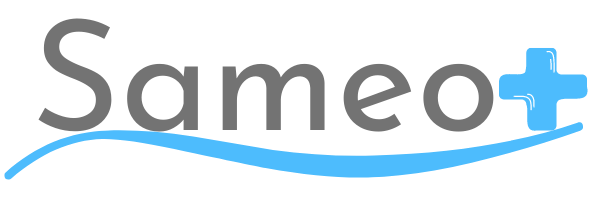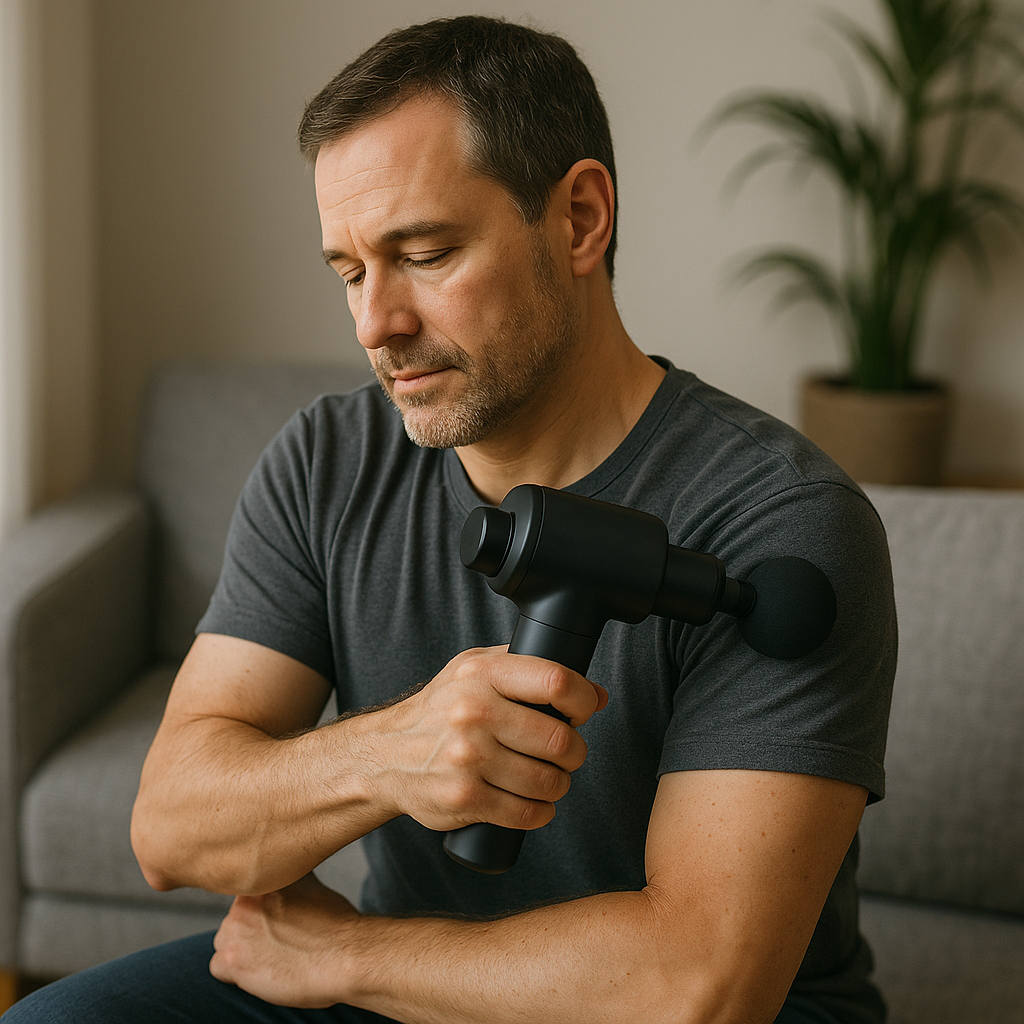Massage guns have become one of the most popular recovery tools for athletes, fitness enthusiasts, and even people with sedentary jobs. Promising to reduce muscle tension, improve circulation, and speed up recovery, these handheld devices claim to deliver the benefits of a professional massage right at home.
But do massage guns really work, or are they just another fitness trend? In this article, we’ll explore how massage guns function, what science says about their effectiveness, and whether they’re truly worth adding to your recovery routine.
How do massage guns work on your muscles?
Massage guns, also known as percussion therapy devices, have revolutionised the way people recover from physical activity, relieve tension, and improve mobility. They use targeted vibrations and rapid pulses to stimulate deep muscle tissues, replicating the effects of a professional sports massage. But how exactly do they work on your muscles and why are they so effective?
Let’s break down the science behind massage guns and how they help your body feel and perform better.
The principle of percussion therapy
Massage guns work through a method called percussion therapy or percussive massage. This involves delivering rapid, repetitive bursts of pressure deep into the muscle tissue. These pulses, which typically range from 2,000 to 3,200 percussions per minute, help to stimulate blood flow, loosen tight muscles, and relieve pain caused by overuse or fatigue.
When you use a massage gun on a specific muscle group, it applies both pressure and vibration, creating micro-movements in the soft tissue. This helps break down knots and adhesions (also known as myofascial trigger points), which are small areas of tension that restrict movement and cause discomfort.
The mechanical stimulation also activates sensory receptors in the skin and muscles, which reduces pain signals sent to the brain — a process known as the “gate control theory” of pain relief. As a result, the body perceives less discomfort while the muscle relaxes naturally.
Increased blood circulation and oxygen delivery
One of the main physiological effects of using a massage gun is improved circulation. The repeated percussive motion encourages blood to flow more freely through the muscles, delivering fresh oxygen and nutrients while helping to flush out metabolic waste like lactic acid.
After intense exercise, lactic acid build-up is one of the main causes of soreness and stiffness. By increasing blood flow, massage guns help accelerate recovery, reduce inflammation, and promote tissue repair. This makes them a valuable tool for athletes or anyone who experiences frequent muscle fatigue.
Muscle relaxation and flexibility
Massage guns also contribute to relaxing tight muscles and improving flexibility. The vibrations stimulate the nervous system, signalling muscles to release tension. This helps restore the natural elasticity of muscle fibres, allowing for greater range of motion.
Regular use before workouts can act as a dynamic warm-up, preparing the muscles for physical activity by boosting circulation and activating motor units (the connection between nerves and muscles). After exercise, it can help reduce post-workout stiffness, promoting faster recovery and better long-term performance.
Breaking down muscle adhesions and scar tissue
Over time, repetitive movements or minor injuries can lead to the formation of muscle adhesions and scar tissue. These are areas where the muscle fibres stick together, limiting movement and causing chronic pain.
The deep, rhythmic pressure from a massage gun helps break down these adhesions, restoring normal tissue function. This is why physiotherapists and sports therapists often recommend percussive therapy for individuals recovering from injuries or dealing with chronic tension in specific areas like the shoulders, calves, or lower back.
Stimulation of the lymphatic system
Massage guns not only improve blood circulation but also support the lymphatic system, which is responsible for removing toxins and excess fluids from the body. Gentle percussive movements encourage lymphatic drainage, helping to reduce swelling, muscle inflammation, and overall fatigue.
This makes massage guns especially beneficial for people with sedentary lifestyles or those who spend long hours sitting, as lymphatic flow tends to slow down without regular movement.
Neurological and psychological benefits
The benefits of massage guns go beyond physical recovery. The vibration and rhythmic stimulation can also have a calming effect on the nervous system, helping to lower stress levels and promote relaxation.
In fact, the brain releases endorphins the body’s natural “feel-good” hormones during and after massage gun use. This combination of physical relief and mental relaxation contributes to an overall sense of well-being and improved sleep quality.
Safe and effective use
To experience these benefits safely, it’s important to use a massage gun correctly. Start with low speed and apply gentle pressure, gradually increasing intensity as your muscles adapt. Focus on each muscle group for no more than one to two minutes, avoiding direct contact with bones, joints, or injuries.
Used consistently and correctly, a massage gun can help maintain optimal muscle health, improve flexibility, and support faster recovery whether you’re an athlete, gym-goer, or simply someone looking to ease daily tension.
What are the main benefits of using a massage gun?
Massage guns have become a must-have tool for athletes, gym-goers, and anyone dealing with muscle tension or fatigue. Designed to deliver rapid pulses of pressure to the body’s soft tissues, these devices provide benefits similar to a deep-tissue massage but in a quicker, more convenient way. Whether you’re using them before, during, or after exercise, massage guns offer a wide range of physical and mental benefits that can improve your recovery, mobility, and overall well-being.
Faster muscle recovery
One of the biggest advantages of a massage gun is its ability to speed up muscle recovery. After a workout, muscles experience microscopic tears that lead to soreness and stiffness. Using a massage gun helps increase blood flow and oxygen delivery, which accelerates the healing process and flushes out lactic acid build-up. This makes recovery faster and less painful, allowing you to get back to training or daily activities sooner.
Relief from muscle pain and stiffness
Massage guns are especially effective for reducing muscle tension and stiffness. The percussive vibrations penetrate deep into the muscle fibres, relaxing tight tissues and breaking up knots that cause discomfort. Regular use helps prevent chronic tension from building up, which can improve posture and reduce the risk of injury.
People who work long hours sitting at a desk can also benefit from using a massage gun on the neck, shoulders, and lower back, as it helps relieve stiffness caused by poor posture or repetitive strain.
Improved blood circulation and flexibility
The rapid pressure movements from a massage gun stimulate blood vessels and promote better circulation throughout the muscles. This not only enhances nutrient and oxygen delivery but also supports the body’s natural recovery processes.
With improved blood flow comes increased muscle flexibility and mobility. Using a massage gun before a workout can help warm up the muscles, reducing the likelihood of strains or injuries.
Reduction of stress and improved relaxation
Massage guns don’t just benefit your body they also help calm your mind. The vibrations stimulate the nervous system, encouraging the release of endorphins, the body’s natural feel-good hormones. This creates a relaxing sensation, easing stress, anxiety, and mental fatigue.
Using a massage gun after a long day can mimic the effects of a relaxing massage, helping you unwind and promoting better sleep quality.
Enhanced performance and overall well-being
By reducing muscle pain, improving mobility, and increasing recovery speed, a massage gun allows you to perform at your best. Whether you’re an athlete aiming to improve endurance or someone simply trying to move more comfortably, consistent use can help maintain muscle health and prevent tightness that limits your range of motion.
Moreover, massage guns support lymphatic drainage, helping the body eliminate toxins and reduce inflammation. This contributes to overall physical wellness and long-term muscle care.
When should you use a massage gun for best results?
Using a massage gun at the right time can make all the difference between average and optimal recovery. While these devices are safe and effective for daily use, the timing of your sessions greatly influences how well they work. Whether you’re warming up before a workout, recovering afterward, or simply easing tension after a long day, knowing when to use a massage gun helps you maximise its benefits safely and efficiently.
Before your workout: to activate and warm up muscles
Using a massage gun before exercise is one of the best ways to prepare your body for movement. A short session of 30 to 60 seconds per muscle group helps increase blood circulation, oxygenate the tissues, and activate your nervous system.
By loosening tight muscles and stimulating blood flow, a pre-workout massage gun routine can:
-
Improve muscle flexibility and range of motion.
-
Reduce the risk of strains or injuries.
-
Prepare your body for higher intensity performance.
Focus on large muscle groups such as the quads, calves, hamstrings, and shoulders, and use a lower speed setting to avoid overstimulation. Think of it as a dynamic warm-up that wakes up your muscles for peak performance.
After your workout: to speed up recovery
One of the most common and effective times to use a massage gun is after exercise. Post-workout use helps relieve tension, reduce lactic acid build-up, and prevent soreness. This is when the massage gun acts as a deep-tissue recovery tool, soothing tight muscles and promoting faster healing.
Applying the massage gun for 1–2 minutes per muscle group after training can:
-
Minimise delayed onset muscle soreness (DOMS).
-
Enhance blood flow and nutrient delivery for faster recovery.
-
Relax tense or fatigued areas after intense physical activity.
For best results, start with moderate pressure and focus on the muscles that feel tight or fatigued. Avoid applying too much force, as the goal is to help the muscles recover, not overstimulate them.
During rest days: to maintain muscle health
Even on non-training days, using a massage gun helps keep your muscles healthy and relaxed. A light 10-minute session during your rest or recovery days supports blood circulation and lymphatic drainage, which helps flush out toxins and reduce inflammation.
This gentle stimulation keeps muscles loose and ready for your next workout, preventing stiffness or tension from building up between sessions.
After long hours of sitting or standing
Massage guns aren’t just for athletes. They’re also excellent for people with sedentary jobs or those who stand for long periods. Using the device in the evening or after work can help alleviate stiffness in the neck, shoulders, and lower back, improving posture and relaxation.
This type of regular use promotes circulation, reduces stress, and improves sleep quality helping your body reset after a long day.



Which shape is best for a knee pillow?
How long should you use a massage gun on one area?